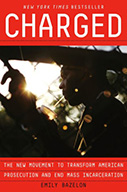Charged: The New Movement To Transform American Prosecution And End Mass Incarceration

Author: Emily Bazelon
Publisher: New York: Random House, 2019. 448p.
Reviewer: Naomi F. Sugie | March 2020
In Charged, Emily Bazelon shines a bright light on a recent movement to reduce incarceration rates in the United States – the election of reform-minded district attorneys. Bazelon is optimistic about the depth and long-lasting effects of criminal justice reform that can result from electing new kinds of prosecutors: for example, prosecutors that prioritize diversion instead of jail or prison, that minimize the use of cash bail, and that address racial disparities (these principles, and others, are outlined in the book’s appendix).
Charged does a remarkable job of describing the recent reform movement to elect a new kind of prosecutor. It is an emotionally touching, insightful, and easy to read book about the power that prosecutors have in the current criminal justice system. Through clear and engaging writing, Bazelon takes the reader through a brief history of prosecutorial discretion and describes the recent efforts of reform-minded district attorneys to change prosecutorial norms. Because prosecutors have so much discretion and power, their ability to make measurable and nearly immediate changes to charging and sentencing decisions is extraordinary. But, it is precisely this unchecked power, combined with prosecutors’ vulnerability as elected stewards dependent on popular support, which makes me less hopeful about the book’s related argument (and secondary part of the subtitle) that this is a promising way to end mass incarceration in the long term. As I will discuss later in this review, in making her case, Bazelon ducks some of the tough questions that require tackling in order for prosecutors to enact lasting and meaningful reforms that substantially reduce incarceration.
Bazelon lays out her argument through the cases of Kevin and Noura. Kevin’s case illustrates how a reform-minded district attorney’s office can give people a second chance. Kevin is arrested for picking up his friend’s gun as the police burst into his friend’s apartment. He claims responsibility for the gun and through a series of opportune breaks is diverted from prison to a year-long community program. After successfully completing the diversion program, his indictment is dismissed and sealed (although not forgotten, as we learn in the Epilogue).
Bazelon contrasts Kevin’s experience with Noura’s case as an example of prosecutorial power gone terribly wrong. Noura was arrested and convicted in the violent killing of her mother.
Days after the conviction, prosecutors filed a motion to submit previously omitted evidence that called into question the testimony of the only witness who had placed her at the scene of the crime. Because of this, as well as the prosecutor’s behavior in her closing argument, Noura’s attorney appealed the conviction to the Tennessee Supreme Court. After more than five years following Noura’s conviction, the Tennessee Supreme Court unanimously decided to overturn the conviction and give Noura the chance for a new trial. For a variety of reasons, however, she ultimately decided to take an Alford plea, which enabled her to maintain her innocence while acknowledging that the state had enough evidence to convict her. After spending a total of 11 years being incarcerated, Noura was eventually released.
Bazelon quickly draws the reader into the lives of Kevin and Noura. Kevin and Noura have both been wronged by a punitive criminal justice system: Noura’s case is devastatingly clear on this point, but Kevin also pays a steep price for deciding, in the split second that the police entered the apartment, to claim responsibility for a gun that was not his. Bringing the reader into the lives of “offenders,” and on their side, is an enormous strength of the book, which contributes to a criminal justice debate that is often characterized by numbers and statistics, at best, or horrible instances of headline-making crimes, at worst.
The focus on individuals as a driving force for change, whether as a device to illustrate prosecutorial power (as through the cases of Kevin and Noura) or as an argument for criminal justice reform (as through the election of reform-minded district attorneys), is a cornerstone of the book’s central orienting axis and argument. Bazelon calls for organizers and advocacy groups to focus their efforts on the election of reform-minded district attorneys and she views this movement as the “most promising means of reform” on the political landscape (296). In this same section, Bazelon briefly refers to another recently published book by law professor Rachel Barkow, who argues against this stance and who instead calls for reforms that reduce the influence of elections and politics in criminal justice policy. Bazelon writes: “[Barkow] fears the reform movement could fizzle, especially if crime rises. I think and hope otherwise, and this book shows why, but it’s a risk worth acknowledging.” I focus on this passage because it raises a core critique that is ever present throughout the book: if prosecutors have so much power to change practice and policy, the change enacted by reform-minded district attorneys seems tenuous and fragile, subject to the whims of an electorate that is likely more responsive to headline-grabbing heinous crimes than to sympathetic cases like Kevin and Noura. As Barkow explains in her book, history shows quite clearly that our most consequential policy changes, which have measurably contributed to the rise of mass incarceration, reflect penal populism and the punitive response of voters focused on rare but horrible crimes (2019). By not taking up this critique in a real and serious way, Bazelon misses a key opportunity to make her case.
In this same vein, Bazelon does not thoroughly confront other questions, such as whether the reform movement, which is fairly recent and localized, will have the ability to transform places like Shelby County, Tennessee where Noura was convicted, and where the prosecutor Amy Weirich continues to serve as district attorney. Focusing on elected officials for reform relies on the belief that reform-minded district attorneys can be elected across the country, including places that are currently expanding their incarceration rates by building more jails and incarcerating more people in pretrial detention. For example, the Vera Institute of Justice has found that pretrial detention rates increased 26% in rural counties between 2003 and 2013 even as these rates declined in large urban counties. Are reform-minded district attorneys electable only in places that are already trying to reduce their incarceration rates through other approaches? What are the chances for electing reform-minded prosecutors in places that continue to expand their jail and prison populations?
Perhaps the most important critique, which Bazelon briefly acknowledges but does not address, is that we need to tackle the “tough” cases—e.g., the people who commit violent crimes—to produce substantial changes in incarceration rates (316). The author presents a list of principles for reform-minded prosecutors to reduce incarceration. For the most part, these recommendations focus on lower-level offenses or specific subgroups (e.g., young people, people who pass eligibility requirements for diversion, etc.), which can reduce the number of admissions to jail or prison but may have little impact on the number of people incarcerated at any one time. The reasoning is this: reforms that target lower-level or nonviolent offenses alone cannot repair the decades of damage done by policies that increase admissions and lengthen sentences, or the “momentum of past policies” (Patterson 2017:9). To reduce incarceration, reforms need to impact the people who are in prison for the longest periods of time, and not only the people who are there for relatively brief periods. In a series of simulated projections,
E.J. Patterson shows that even large reforms to how we treat nonviolent offenses will not halt (let alone reduce) incarceration rates. Rather, reform efforts need to also target people who commit violent offenses, both in terms of admissions and sentence length. Patterson’s analyses assume that violent offenses are treated the same in the future as they are treated currently, but recent reform efforts have sometimes involved ratcheting up punitive responses for violent offenses (e.g., Beckett et al. 2016; Gottschalk 2015; Seeds 2017) alongside diversion and reductions for nonviolent offenses. The “bifurcation” of groups into nonviolent offenders, who are deserving of reform efforts, and violent offenders, who need harsher deterrents, is a troubling trend that will not reduce mass incarceration.
Mass incarceration is the product of decades of changes related to prosecutors, judges, policies, institutional practices, and legal doctrine, among others. Emily Bazelon gives us an emotionally compelling and captivating look at one of these levers – prosecutors. But, we will need to work on all of these fronts, over a concerted period of time, and across diverse geographic regions, to substantially reduce our country’s perverse experiment in mass incarceration.
References Cited
Barkow, R.E. (2019). Prisoners of Politics: Breaking the Cycle of Mass Incarceration. Harvard, MA: Belknap Press.
Beckett, K., Reosti, A., and Knaphus, E. (2016). The End of an Era? Understanding the Contradictions of Criminal Justice Reform. The ANNALS of the American Academy of Political and Social Science 664(1):238-259.
Gottschalk, M. (2015). Caught: The Prison State and the Lockdown of American Politics.
Princeton, NJ: Princeton University Press.
Patterson, E.J. (2017). The Strategies, Complexities, and Realities of Zero Population Growth.
Social Sciences 6(60):1-13.
Seeds, C. (2017). Bifurcation Nation: American Penal Policy in Late Mass Incarceration.
Punishment and Society 19(5):590-610.
Naomi F. Sugie Assistant Professor, Department of Criminology, Law and Society University of California, Irvine


